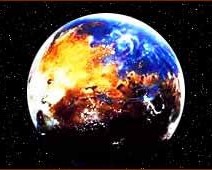 |
| What We Know About the Red Planet | ||||
| History | Water | Ice | Air | Canals |
| Seasons | Mountains | Rocks | SandDunes | Rift Valley |
| Moons | Dust Storms | Stats | Closest | Kid Pix |
| Lunar | Movies | Life Search | Wanted | Exploring Mars |
Mars was closest to Earth in recorded history:
A Neighborly Visit in 2003
In the year 2003, Mars was closer to Earth than any previous time in recorded human history.
Earth as seen from Mars by the Global Surveyor
click to enlarge digitally enhanced image
Credit: NASA/JPL/MSSS
On August 27, 2003, Earth and Mars were a short 34,647,658 miles (55,760,000 kilometers) apart.
The two planets had not been that close in some 60,000 years.
It was great news for astronomers because the Red Planet appeared unusually large in diameter. That made it relatively easy to resolve features on the martian surface with a large telescope.
In fact, Mars appeared very bright and its red-orange color was quite conspicuous.
One frustration for astronomers, however, was a huge dust storm that happened to be raging over a third of Mars' surface, obscuring some features. More on the dust storm »
Learn more: Human Exploration of Mars:
There have been three stages of exploration so farFlybys:
Probes fly by Mars taking pictures Orbiters:
Spacecraft fly into orbit above MarsLanders and Rovers:
- Orbiters
- Mariner 8-9
- Viking 1-2
- Mars Observer
- Mars Climate Orbiter
- Mars Global Surveyor
- Mars Global Surveyor home
- 2001 Mars Odyssey
- 2001 Mars Odyssey home
- Mars Express
- Mars Express home
- Mars Reconnaissance Orbiter 2005
- Mars Reconnaissance Orbiter home
Landers and rovers drop to the surfaceSand dunes: Dust Storms: Air: Carbon Dioxide: Outflow Channels: Valley Networks: Rift Valley: Ice: Ice caps: Frost: Water: Artesian Water: Mars Weather: Mars Photo Galleries: Planet features: Canals: Rocks: Mountains: Dating and aging: Seasons:

